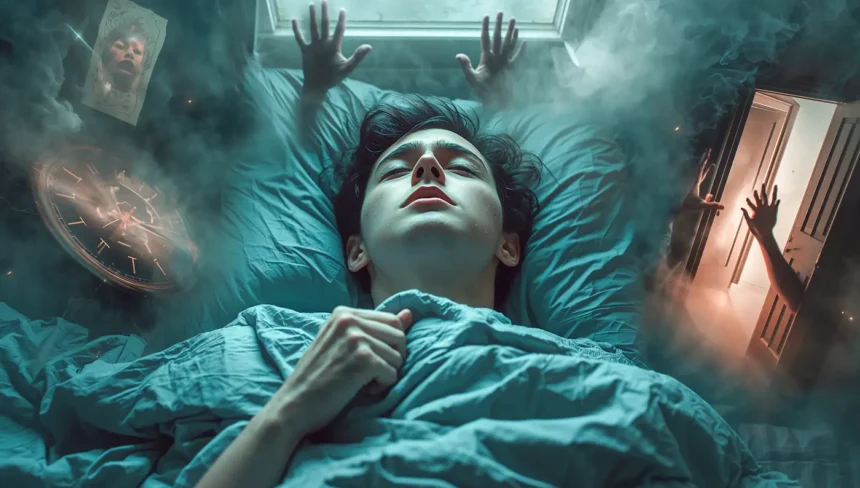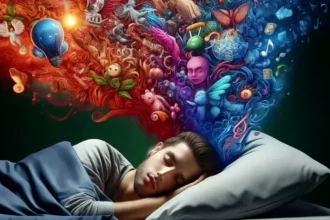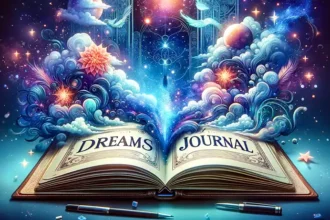Nightmares Aren’t Warnings, They’re Messages with Teeth
You wake up sweating. Heart pounding. Your brain’s on fire with images you didn’t choose. Most people call that a nightmare.
- Nightmares Aren’t Warnings, They’re Messages with Teeth
- Why Nightmares Aren’t Useless (Even When They Feel Like Hell)
- What Your Nightmare Is Actually Doing in Your Head
- From Symbol to Insight: How Bad Dreams Speak in Code
- How to Turn a Nightmare Into a Creative Breakthrough
- When Nightmares Are a Sign of Something Deeper
- Nightmares Are Messy, But They’re Meaningful
- Further Reading
- FAQ
I call it a creative telegram with bad handwriting.
Bad dreams aren’t just trauma echoes. They’re compressed metaphors, emotional pressure cookers, and subconscious puzzles. The worse the dream feels, the richer its symbolic payload usually is.
This isn’t woo. It’s neuroscience, psychology, and symbolic cognition doing a weird dance. And when interpreted right, even your ugliest nightmares can become creative tools, stories, insights, decisions, or breakthroughs.
In this piece, we’ll walk through how to reframe nightmares, not just decode, but alchemize. Think of it as dream-judo: using your subconscious force, not fighting it.
Because inside every nightmare, there’s an emotional core. Fear, grief, envy, lust, betrayal, all wrapped in surreal imagery.
And if you can sit with it, extract it, you can write, create, or rewire yourself with it.
Why Nightmares Aren’t Useless (Even When They Feel Like Hell)
Most people try to erase bad dreams. Wrong move. Your mind doesn’t spend psychic energy on nothing. Nightmares are expensive.
They’re built from real material, unprocessed emotion, memory fragments, psychological dissonance.
A nightmare isn’t just replaying trauma. It might be simulating what you’re afraid to feel while awake. Dreams don’t censor.
That makes them valuable, even when disturbing.
They also carry what Carl Jung called the “shadow”, the parts of you you suppress. Nightmares shove that shadow in your face. Rude? Yes. Useful? Absolutely.
Modern neuroscience backs this up. Studies show nightmares often help regulate emotional memory, especially fear responses.
So instead of dismissing nightmares as scary glitches, start treating them like encrypted insights. They’re ugly messengers, but they always know something you don’t.
What Your Nightmare Is Actually Doing in Your Head
Your nightmare doesn’t hate you. It’s trying to get your attention. It’s just bad at customer service. Screaming snakes? Lost teeth?
A faceless ex? That’s dream-speak for “something’s off.”
Behind every surreal horror is a pattern, emotion, conflict, desire, or dread, that hasn’t found a waking outlet. Nightmares are just unedited drafts of that inner script. Raw. Awkward. Honest.
And here’s the kicker: your brain knows what it’s doing. Studies from Harvard’s Sleep Lab show nightmares help process “unintegrated affect”, emotions that don’t fit your daily behavior.
Think of a nightmare as emotional compression. It’s your mind’s way of filing the unresolved. But sometimes, the filing system explodes, and it bleeds into surreal storylines.
Fear of failing? Your dream might throw you off a cliff. Avoiding confrontation? You’re being chased by someone with your dad’s voice and your ex’s haircut.
If that sounds chaotic, it is. But it’s also specific. That’s the power.
A nightmare won’t lie to you, it just won’t say it nicely.
So stop flinching. Start decoding. There’s creative gold inside the chaos, if you’re willing to stay awake to it.
From Symbol to Insight: How Bad Dreams Speak in Code
Your nightmares aren’t literal. They’re symbolic explosions. Don’t interpret them like a tweet, interpret them like poetry dipped in panic.
Every monster, chase, or glitchy setting is just a metaphor trying to break through.
The trick is to decode emotionally, not logically. Don’t ask: what does this mean? Ask: how did I feel?
The feeling is the key. The image is just its disguise.
For example, drowning in a dream might not be about water, it could be emotional overwhelm, intimacy fear, or just your inbox. The water’s just a costume.
Dream language uses compression. A single scene can pack years of buried memory. That’s why bad dreams feel so intense, they carry emotional concentration.
Small scene, huge meaning.
Here is the properly formatted, verified quote you can include in your article as a standalone paragraph:
“Dreaming always makes new connections … It is a creative product, not a replay of waking material.”
(Dr. Ernest Hartmann, Professor of Psychiatry, Tufts University School of Medicine, 1998)
Once you identify the core emotion, shame, fear, longing, guilt, you can flip the dream. Use that material. Turn it into a question, a scene, a project, a poem.
Symbol becomes story. Chaos becomes creativity. That’s not woo.
That’s your subconscious offering raw content. Use it.

How to Turn a Nightmare Into a Creative Breakthrough
Once you’ve stopped flinching and started decoding, your nightmare becomes something better: content. Emotional, rich, layered content. The kind that can turn into insight, plotlines, or even clarity.
That faceless villain chasing you? That endless loop where you fail again and again? It’s not nothing. It’s fuel.
But only if you handle it without judgment.
Start by identifying the core emotional pattern. Then flip it: What could this become in your art, your work, your life? Not escape, transformation.
Here’s how nightmare scenes translate into creative insight:
| Nightmare Scene | Possible Creative Translation |
|---|---|
| Being chased endlessly | Story about fear of truth, identity crisis, impostor syndrome. |
| Losing control of a vehicle | Metaphor for grief, leadership anxiety, fear of instability. |
| Speaking but no one hears you | Theme of invisibility, marginalization, silenced truth. |
| Falling from the sky | Creative risk metaphor, letting go of perfectionism. |
| Monster with familiar eyes | Explore shadow selves, duality, family or relationship tension. |
Bad dreams don’t need to stay nightmares. They can become short stories, business ideas, new boundaries, or emotional clarity. The trick is asking the right question: What is this trying to show me?
Dreams distort, but they never lie. Listen better. Then use it.
When Nightmares Are a Sign of Something Deeper
Some nightmares aren’t just symbolic. They’re symptoms. If you’re having the same bad dream on repeat, weeks, months, years, it’s not just your subconscious being poetic.
It’s waving a red flag.
Nightmares tied to trauma, chronic stress, or mental health issues tend to recur. They can disrupt sleep cycles, trigger anxiety, and leave your nervous system on high alert long after you’re awake.
This isn’t rare. Nightmares affect roughly 2–8% of adults chronically. And in people with PTSD or unresolved trauma, that rate spikes sharply.
A one-off nightmare is a creative opportunity. A recurring one? That’s a cue to listen harder.
You may need more than dream journaling, you might need professional support to fully unpack it.
Therapists trained in dream work or trauma integration can help you navigate that emotional content without retraumatizing. You’re not weak for needing help, you’re smart for decoding the alarm before it breaks you.
Just like pain in the body points to injury, repeated nightmares point to psychic overload. Don’t ignore it. Bad dreams are loud for a reason.
Sometimes the bravest thing you can do is sit with the fear… and then get help turning it into something new.
Nightmares Are Messy, But They’re Meaningful
A nightmare isn’t the enemy. It’s a message wrapped in emotional chaos. The trick isn’t to erase it, it’s to translate it.
By sitting with the discomfort, decoding the symbols, and understanding the emotional tone, you can turn fear into fuel. That’s how shadow becomes insight.
Here’s one last way to rethink your nightmare, as raw creative material, not a psychological glitch:
| Nightmare Pattern | Reframed Insight Prompt |
|---|---|
| Trapped, can’t escape | What situation am I tolerating that I know I shouldn’t? |
| Being watched or followed | Where in life do I feel exposed, judged, or performative? |
| Endless repetition or loops | What emotional pattern keeps replaying in my waking life? |
| Natural disasters | What change am I avoiding that feels too big to control? |
| Can’t speak or scream | What truth am I scared to say out loud? |
Dreams do what daytime often can’t, they strip you raw, fast. Don’t waste that intensity. Turn it into language. Or vision. Or action.
Even the worst dreams contain a version of the truth. And sometimes, truth looks terrifying right before it frees you.
Further Reading
“Why Do We Dream?”, Sleep Foundation
Explains key theories of dreaming: memory consolidation, emotional processing and more.
https://www.sleepfoundation.org/dreams (Sleep Foundation)
“Why We Have Nightmares (And How to Prevent Them)”, Sleep Foundation
Covers nightmares, triggers, and how they may reflect emotional or physiological issues.
https://www.sleepfoundation.org/nightmares (Sleep Foundation)
“How Your Most Bizarre Dreams Can Help You”, Psychology Today
Discusses how odd or disturbing dreams can function as creative or emotional insight.
https://www.psychologytoday.com/us/blog/dreaming-in-the-digital-age/202110/how-your-most-bizarre-dreams-can-help-you (Psychology Today)
“The Creative Power of Your Sleep: 10 Easy Practices”, Psychology Today
Focuses on how inspiration and creative thinking can emerge even from bad dreams and nightmares.
https://www.psychologytoday.com/nz/blog/dreaming-in-the-digital-age/201908/the-creative-power-of-your-sleep-10-easy-practices (Psychology Today)
“Managing Nightmares”, Psychology Today
A practical overview of nightmare themes, when they become problematic and how to intervene or reinterpret them.
https://www.psychologytoday.com/us/basics/sleep/understanding-treating-nightmares
FAQ
How Common Nightmares Reflect Six Key Psychological Aspects
| Aspect | Being Chased | Falling | Losing Voice |
|---|---|---|---|
| Core Emotion | Fear of danger. | Feeling overwhelmed. | Pursuit of unresolved issues. |
| Subconscious Trigger | Insecurity. | Fear of loss. | Fear of inadequacy. |
| Symbolic Meaning | Striving for control. | Desire for freedom. | Need for expression. |
| Creative Reframe | Transform fear into motivation. | Use vulnerability for creativity. | Channel frustration into art. |
| Emotional Lesson | Recognize and confront fears. | Embrace change and uncertainty. | Find your voice and assert yourself. |
| Actionable Insight | Take proactive steps. | Explore new opportunities. | Engage in self-expression. |


























